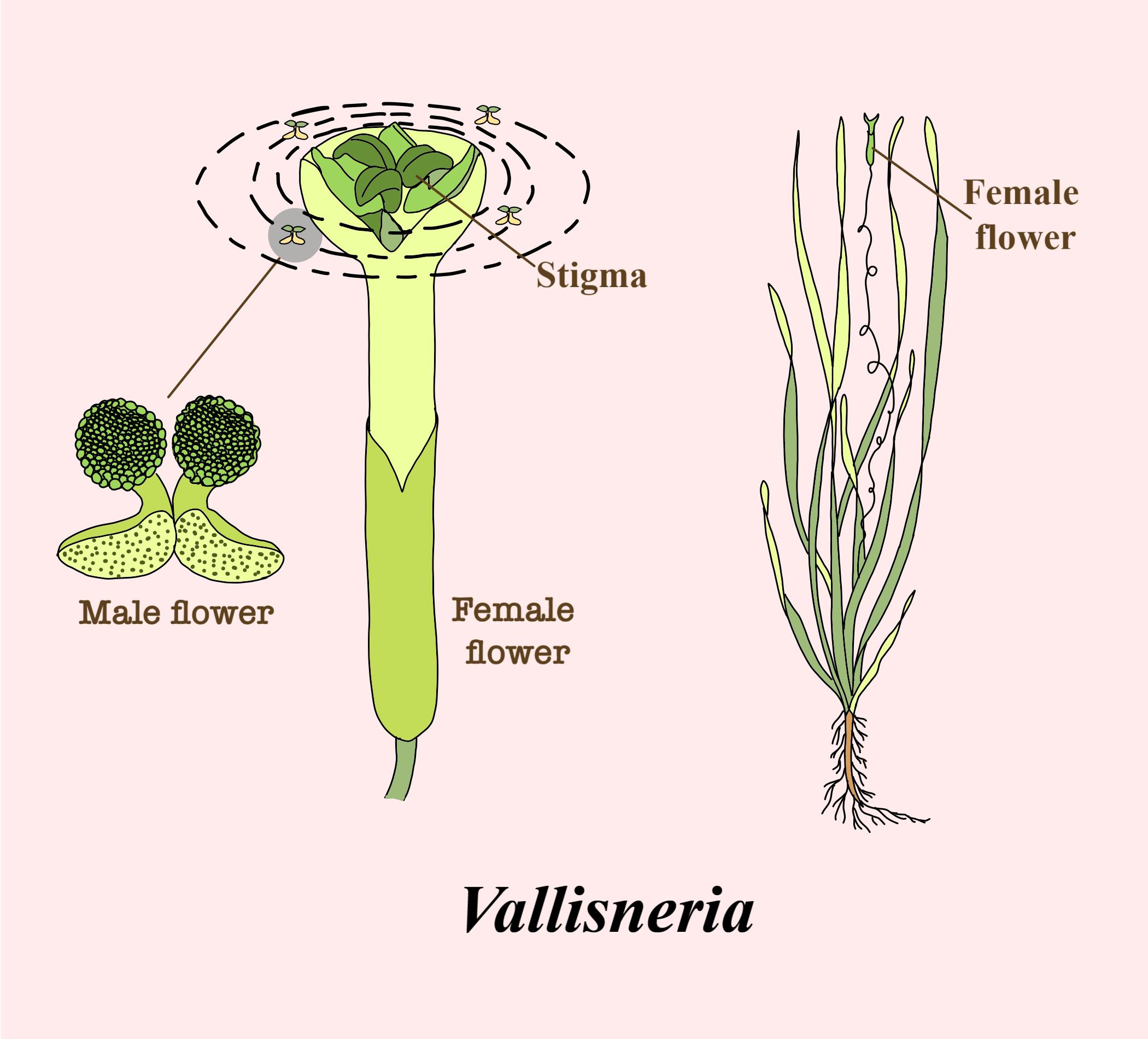
The plant of Vallisneria is
(a) Monoecious
(b) Dioecious
(c) Polygamous
(d) Intersexual
Answer
508.8k+ views
Hint: The presence of male and female sex organs in different individual plants or a plant that contain flowers with either androecium or gynoecium but not both of them together within the same flower.
Complete answer:
Higher plants like gymnosperms contain male sex organ anther and female sex organ stigma. If the male sex organ and female sex organs are present on the same plant it is referred to as bisexual or monoecious and if male and female sex organs are present on different individual plants they are called unisexual or diecious. Vallisneria is a submerged rooted hydrophyte that contains male and female sex organs on different individuals. So, it is referred to as diecious.
Additional Information: - Plants that grow in water or in very wet places are hydrophytes. These are further subdivided into five categories according to their mode of living in the water. Free-floating hydrophytes, Rooted hydrophytes with floating leaves, Submerged suspended hydrophytes, Submerged rooted hydrophytes, and Amphibious plants
- Vallisneria belongs to submerged rooted hydrophytes.
- Being dioecious i.e, monosexual and submerged, pollination in these plants takes place with the help of water currents. This type of pollination is called hydrophilic pollination where male gametes carry pollen grains to the female plant's stigma and fertilization takes place.
- In plant kingdom, many of the higher plants are monoecious i.e, bisexual.
- If a plant contains flowers of both male and female sex organs and with flowers of either male or female sex organs within the same plant, then they are called polygamous. Examples: hellebore, catchfly
So, the correct answer is ‘Diecious’.
Note: Ginkgos, African teak, cannabis, and willows are some of the examples of dioecious plants.
Some of the morphological adaptations of Vallisneria are long, slender, and flexible stem, fibrous and adventitious roots, thin leaves.

Complete answer:
Higher plants like gymnosperms contain male sex organ anther and female sex organ stigma. If the male sex organ and female sex organs are present on the same plant it is referred to as bisexual or monoecious and if male and female sex organs are present on different individual plants they are called unisexual or diecious. Vallisneria is a submerged rooted hydrophyte that contains male and female sex organs on different individuals. So, it is referred to as diecious.
Additional Information: - Plants that grow in water or in very wet places are hydrophytes. These are further subdivided into five categories according to their mode of living in the water. Free-floating hydrophytes, Rooted hydrophytes with floating leaves, Submerged suspended hydrophytes, Submerged rooted hydrophytes, and Amphibious plants
- Vallisneria belongs to submerged rooted hydrophytes.
- Being dioecious i.e, monosexual and submerged, pollination in these plants takes place with the help of water currents. This type of pollination is called hydrophilic pollination where male gametes carry pollen grains to the female plant's stigma and fertilization takes place.
- In plant kingdom, many of the higher plants are monoecious i.e, bisexual.
- If a plant contains flowers of both male and female sex organs and with flowers of either male or female sex organs within the same plant, then they are called polygamous. Examples: hellebore, catchfly
So, the correct answer is ‘Diecious’.
Note: Ginkgos, African teak, cannabis, and willows are some of the examples of dioecious plants.
Some of the morphological adaptations of Vallisneria are long, slender, and flexible stem, fibrous and adventitious roots, thin leaves.

Recently Updated Pages
Ncert Books Class 10 Science Chapter 2 Free Download

Ncert Books Class 11 Biology Chapter 16 Free Download

Ncert Books Class 11 Biology Chapter 12 Free Download

Ncert Books Class 11 Biology Chapter 10 Free Download

Ncert Books Class 11 Chemistry Chapter 7 Free Download

Ncert Books Class 11 Physics Chapter 8 Free Download

Trending doubts
Which are the Top 10 Largest Countries of the World?

Differentiate between homogeneous and heterogeneous class 12 chemistry CBSE

Why is the cell called the structural and functional class 12 biology CBSE

a Tabulate the differences in the characteristics of class 12 chemistry CBSE

Who discovered the cell and how class 12 biology CBSE

Draw a labelled sketch of the human eye class 12 physics CBSE




